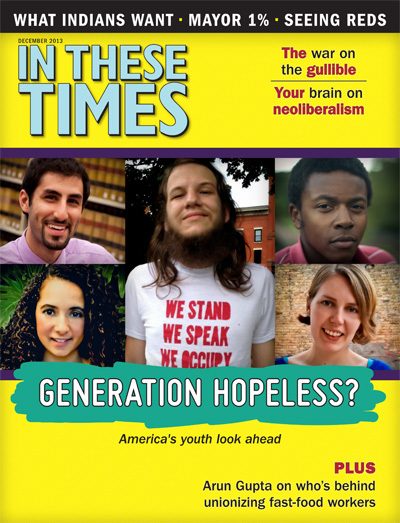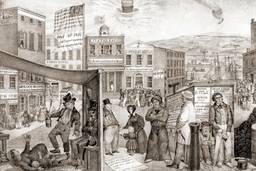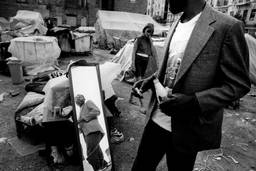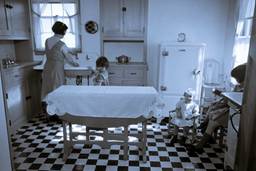The Spooks Next Door
How suburbia emerged alongside America’s covert foreign interventions.
Margaret Garb

In the early 1950s, Eleanor Dulles built a windowed, modernist house in McLean, Va. Dulles, a Harvard-trained economist who worked at the State Department was the sister of both a Secretary of State and a CIA director, and her home quickly became a cozy cocktail lounger where the Dulles brothers could down martinis and rye whiskey while planning American interventions in Guatemala, the Congo, Iran, Cuba and Vietnam, to name a few.
The house was not just a suburban bungalow; it was an example of the new architecture that suggested both the transparency and the privacy of suburban housing. It was also a lynchpin for a new community of Washington insiders growing in Northern Virgina, just across the border from D.C. Eleanor Dulles’ residence there was one reason Allen Dulles determined in 1954 to build the new CIA headquarters in Langley, a wooded section of McLean along the Potomac River (and the former site of the Robert E. Lee family plantation). The Dulles Corridor, as the area would come to be known, ran between the CIA building, which opened in 1961, and the airport named for Allen’s brother, John Foster Dulles. It had also become a kind of covert landscape linking the internalized world of suburban culture to the covert world of American imperial activities abroad.
In the years following World War II, America became a global empire, presenting itself as a beacon of democracy while engaging in covert warfare to overthrow despots and democrats around the globe. At the same time, white professionals and striving working-class families were fleeing urban neighborhoods, moving to newly built suburbs and creating a landscape of single-family houses on tidy yards. The neighborhoods surrounding Eleanor Dulles’ home were double-edged worlds, with the hidden activities of thuggish spooks and unhappy nuclear families shadowed by popular images of contented white bourgeois domesticity.
That suburbia — or at least the suburbs of northern Virginia — emerged alongside America’s covert foreign interventions is no coincidence, writes Andrew Friedman in Covert Capital: Landscapes of Denial and the Making of U.S. Empire in the Suburbs of Northern Virginia, an innovative study of post-war American foreign policy on the home front. The covert capital, the northern Virginian analogue to the overt capital in D.C. proper, produced the human and material capital that made for efficient, methodical, secretive and bloody operations abroad. The purity and ostensible simplicity of suburban family life, Friedman says, nurtured the violent activities of so many of McLean’s residents. “The geography of empire,” he writes, “reproduced itself at home in architecture and spatial relations” just as the home front “incubated the empire.”
American suburbia no doubt contained a politics that was often obscured by simplistic images of the happy nuclear family. Betty Friedan, decades ago, linked the suburban personal to the national political. Friedman similarly wants to draw a straight line between the “covert capital” of northern Virginia and the geopolitical world of covert action overseas, and the book provides incisive accounts of U.S. interventions in Vietnam, Latin America and Iran. “This study, he writes, “brings U.S. imperialism to the doorstep of everyday middle-class American life in the contemporary era.” He offers and almost gossipy listing of famous spooks and their handlers who built sumptuous suburban houses in McLean — from Robert Kennedy’s Hickory Hill to the homes of Edward Lansdale, the inventor of U.S. counterinsurgency in the Philippines and Vietnam; James Jesus Angleton, head of CIA counterintelligence; and Lucien Conein, who oversaw the coup against Ngo Dinh Diem in Vietnam. These and others formed “social networks” while their wives worked, ran charities, raised children and wrote novels. Power surged through backyard barbecues or moved from hand to hand in late-night poolside chats, as secretive plans were hatched and made real.
Decades later, the Iran-Contra scandal underwrote continued suburban growth in Northern Virginia, as several contractors working with the National Security Council turned their talents to suburban development and several “imperial repatriates” — typically elite Iranians forced out after the 1979 revolution—became leading developers of housing and malls in the area. More disturbing were the migrants fleeing American-funded death squads in Latin America who became the low-wage workers who built suburban houses and cleaned suburban offices. Labor and capital from covert activities abroad were literally visible in the Dulles Corridor.
Covert Capital is an engaging read, and Friedman’s argument is clever and original, though not entirely persuasive; at times it seems he is simply playing on a metaphor rather than building a case for the link between suburban forms and foreign policy. The suburban house and the “spatial relations” of suburbia appeared across the United States in the post-war years, in places far from the “covert capital.” The specific form of American suburbs was generated by federal housing and urban policies, social conflict over civil rights and a racist white backlash, along with various other social and political forces. America’s imperial ambitions may be part of the mix, but certainly not the guiding force. Most suburbs were homes for white professionals and blue-collar unionized workers who found home ownership a path to economic security. The residents of McLean, in other words, were no ordinary suburbanites, as they worked to depose iran’s democratically elected prime minister, Mohammad Mosaddegh, or ran counter-insurgency campaigns in El Salvador and Nicaragua. McLean, it seems, was just another company town.
But Friedman has a point. There was — maybe still is — a zombie wandering America’s suburban streets, or, as Friedman suggests, a “body-snatcher undertone.” The zombie might be seen in steady racial and class segregation in suburban housing; or in the hard-working resentful wives so often portrayed as happy homemakers; or in all the invisible workers who clean houses and offices and who build the roads, bridges, and sewage and water systems that make possible an image of suburbia as a place without workers, removed from racial and labor conflicts.
America’s covert foreign ventures abroad brought workers and capital to American suburbs, and allowed Americans to proclaim with righteous fervor their goodness and exceptional place in the world. Suburbia, meanwhile, concealed in plain sight the covert policies that generated so much savage racial and labor violence at home and abroad.








